Characterization of Surface–Borehole Transient Electromagnetic Response in Electrical Anisotropic Media
Abstract
1. Introduction
2. Basic Theory
2.1. Control Equations
2.2. Spatial and Time Domain Discretization
3. Algorithm Verification
3.1. The One-dimensional (1D) Anisotropy Model
3.2. 3-D Isotropic Model
3.3. Anisotropic Half-Space Model
4. Surface—Borehole TEM Response Study of Electrically Anisotropic Media
4.1. Principal Axis Anisotropic Strata
4.2. Principal Axis Anisotropic 3-D Anomaly
5. Discussion
Author Contributions
Funding
Data Availability Statement
Conflicts of Interest
References
- Zang, D.F.; Zhu, L.F.; Zhang, F.M.; Sheng, J.G.; Sheng, Y.J.; Wang, Z.L. Theory Study for Transient Electromagnetic Logging III: Electromagnetic Wave. Well Logging Technol. 2014, 38, 530–534. [Google Scholar]
- Dang, R.R.; Qin, Y.; Xie, Y.; Wang, H.N. Study of 3-C induction log system. Oil Geophys. Prospect. 2006, 4, 484–488. [Google Scholar]
- Yi, H.C. Study on the electromagnetic response characteristics of ground-well transients. Geophys. Geochem. Explor. 2018, 42, 970–976. [Google Scholar]
- Gao, J. Experimental study on transient electromagnetic logging method. Energy Technol. Manag. 2016, 41, 179–180. [Google Scholar]
- Bailey, J.; Lafrance, B.; McDonald, M.A.; Fedorowich, S.J.; Kamo, S. Mazatzal Labradorian-age ductile deformation of the South Range Sudbury impact structure at the Thayer Lindsley mine, Ontario. Can. J. Earth Sci. 2004, 41, 1491–1505. [Google Scholar] [CrossRef]
- Molnar, F.; Watkinson, D.H.; Jones, P.C. Fluid inclusion evidence for hydrothermal enrichment of magmatic ore at the contact zone of the Ni-Cu-platinum-group element 4b Deposit, Lindsley Mine, Sudbury. Can. Econ. Geol. 1997, 92, 674–685. [Google Scholar] [CrossRef]
- Deng, X.H.; Zhang, J.; Wu, J.J.; Wang, X.C.; Yang, Y. Technology design. In Protocols of Surface-Borehole Transient Electromagnetic Method, 1st ed.; China Geological Survey, Ministry of Natural Resources: Beijin, China, 2019; Volume 5, pp. 2–3. [Google Scholar]
- Klein, J.D.; Martin, P.R.; Allen, D.F. The petrophysics of electrically anisotropic reservoirs. Log Anal. 1997, 38, 25–36. [Google Scholar]
- O’Brien, D.P. Electromagnetic fields in an N layer anisotropic half space. Geophysics 1967, 4, 668–677. [Google Scholar] [CrossRef]
- Weiss, C.J.; Newman, G.A. Electromagnetic induction in a fully 3-D anisotropic earth. Geophysics 2002, 67, 1104–1114. [Google Scholar] [CrossRef]
- Pek, J.; Santos, F. Magnetotelluric impedances and parametric sensitivities for 1-D anisotropic layered media. Comp. Geosci. 2002, 28, 939–950. [Google Scholar] [CrossRef]
- Deng, S.G.; Liu, T.L.; Wang, L.; Wang, Z.; Yuan, X.; Zhang, P.; Cai, L. Analytical solution of multicomponent induction logging response in biaxial anisotropic medium. Chin. J. Geophys. 2020, 63, 362–373. [Google Scholar]
- Liu, Y.H.; Yin, C.C.; Cai, J.; Huang, W.; Ben, F.; Zhang, B.; Qi, Y.; Qiu, C.; Ren, X.; Huang, X.; et al. Review on research of electrical anisotropy in electromagnetic prospecting. Chin. J. Geophys. 2018, 61, 3468–3487. [Google Scholar]
- Li, H.; Xue, G.Q.; Zhong, H.S.; Di, Q.Y. Joint inversion of CMP gather og multi-channel transient electromagnetic data. Chin. J. Geophys. 2016, 59, 4439–4447. [Google Scholar]
- Xu, S.; Zhao, S. Finite element method solutions for geodetic electromagnetic fields in two-dimensional anisotropic geoelectric sections. Earthq. Sci. 1985, 1, 80–90. [Google Scholar]
- Yu, L.; Evans, R.L.; Edwards, R.N. Transient electromagnetic responses in seafloor with triaxial anisotropy. Geophys. J. Int. 1997, 129, 292–304. [Google Scholar] [CrossRef]
- Wang, C.X.; Zhou, C.; Chu, Z.; Wei, Y.; Jin-Song, S. Modeling of electromagnetic responses in frequency domain to electrical anisotropic formations. Chin. J. Geophys. 2006, 6, 1873–1883. [Google Scholar]
- Sun, X.Y.; Nie, Z.P.; Zhao, Y.W.; Li, A.Y.; Luo, X. The electromagnetic modeling if logging-while-drilling tool in tilted anisotropic formations using vector finite element method. Chin. J. Geophys. 2008, 51, 1600–1607. [Google Scholar]
- Chen, G.; Wang, H.; Yao, J. Modeling of electromagnetic responses of 3-D electrical anomalous body in a layered anisotropic earth using integral equations. Chin. J. Geophys. 2009, 52, 2174–2181. [Google Scholar]
- Dennis, Z.R.; Cull, J.P. Transient electromagnetic surveys for the measurement of near-surface electrical anisotropy. J. Appl. Geophys. 2012, 76, 64–73. [Google Scholar] [CrossRef]
- Yan, L.; Zhou, L.; Xie, X.; Wang, Z.G. The Transient electromagnetic responsein of electrical anisotropic reservoir model. Chin. J. Eng. Geophys. 2014, 11, 346–350. [Google Scholar]
- Wang, Y.X. Study on the 1-D Positive Inversion Method of Electrical Source Transient Electromagnetism in Anisotropic Media. Master’s Thesis, University of Electronic Science and Technology of China, Chengdu, China, 2019. [Google Scholar]
- Zhou, J.M.; Liu, W.T.; Li, X.; Qi, Z.; Liu, H. Research on the 3D mimetic finite volume method forloop-source TEM response in biaxial aniso-tropic formation. Chin. J. Geophys. 2018, 61, 368–378. [Google Scholar]
- Liu, Y.; Hu, X.; Peng, R.; Yogeshwar, P. 3D forward modeling and analysis of the loop-source transient electromagnetic method based on the finite-volume method for an arbitrarily anisotropic medium. Chin. J. Geophys. 2019, 62, 1954–1968. [Google Scholar]
- Liu, Y. Three-Dimensional Anisotropy Forward and Analysis of Time-Domain Electromagnetic Method. Ph.D. Thesis, China University of Geosciences, Beijing, China, 2020. [Google Scholar]
- Guo, J.L.; Jiang, T.; Guo, H. Characteristics of axial anisotropic borehole transient electromagnetic three-component response. J. Earth Sci. Environ. 2020, 42, 737–748. [Google Scholar]
- Guo, J.; Gao, X.; Hou, Y. Research on three-component responses characteristics of axial anisotropy tunnel-hole transient electromagnetic. Coal Geol. Explor. 2022, 50, 52–62. [Google Scholar]
- Yin, C.C. Geoelectrical inversion for a one-dimensional anisotropic model and inherent non-uniqueness. Geophys. J. Int. 2010, 1, 11–23. [Google Scholar] [CrossRef]
- Pek, J.; Santos, F. Magnetotelluric inversion for anisotropic conductivities in layered media. Phys. Earth Planet. Inter. 2006, 158, 139–158. [Google Scholar] [CrossRef]
- Um, E.S.; Harris, J.M.; Alumbaugh, D.L. 3D time-domain simulation of electric-field approach. Geophysics 2010, 75, 115–126. [Google Scholar] [CrossRef]
- Yu, C. Introduction of PARDISO Solution Method for Large-Scale Sparse Matrix; Intel Asia Pacific Research and Development Center: Shanghai, China, 2002. [Google Scholar]
- Liu, Y.; Pritam, Y.; Hu, X.; Peng, R.; Tezkan, B.; Mörbe, W.; Li, J. Effects of electrical anisotropy on long-offset transient electromagnetic data. Geophys. J. Int. 2020, 222, 1074–1089. [Google Scholar] [CrossRef]
- Commer, M.; Newman, G. A parallel finite-difference approach for 3D transient electromagnetic modeling with galvanic sources. Geophysics 2004, 69, 1192–1202. [Google Scholar] [CrossRef]
- Liu, S.; Sun, H.; Li, W.; Wang, Z.; Yang, Y. New algorithm for transient electromagnetic BEDS-FDTD 3-D forward and stability verification. Chin. J. Geophys. 2023, 66, 841–853. [Google Scholar]
- Yin, C.; Qi, Y.; Liu, Y. 3D time-domain airborne EM modeling for an arbitrarily anisotropic earth. J. Appl. Geophys. 2016, 131, 163–178. [Google Scholar] [CrossRef]



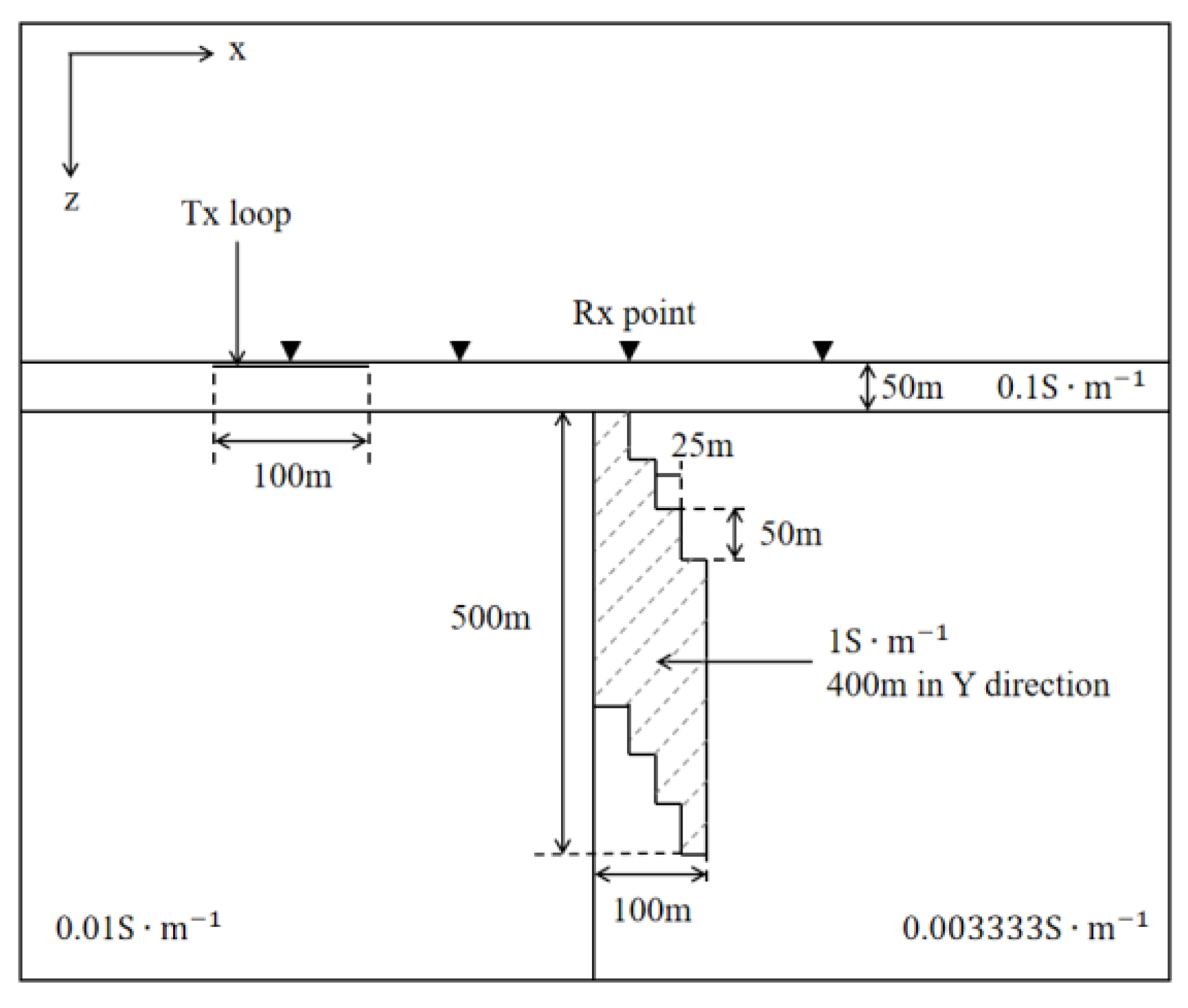

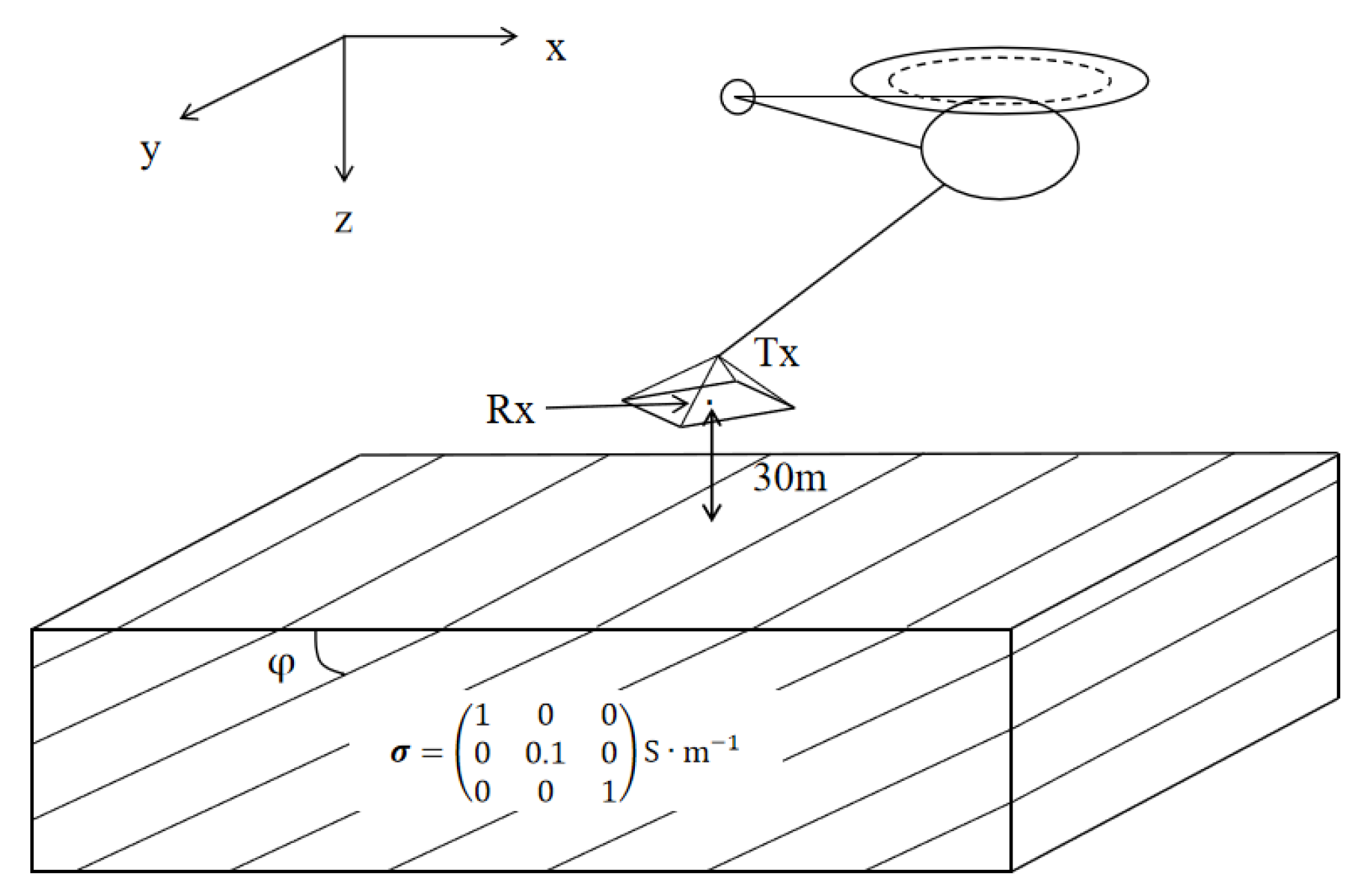

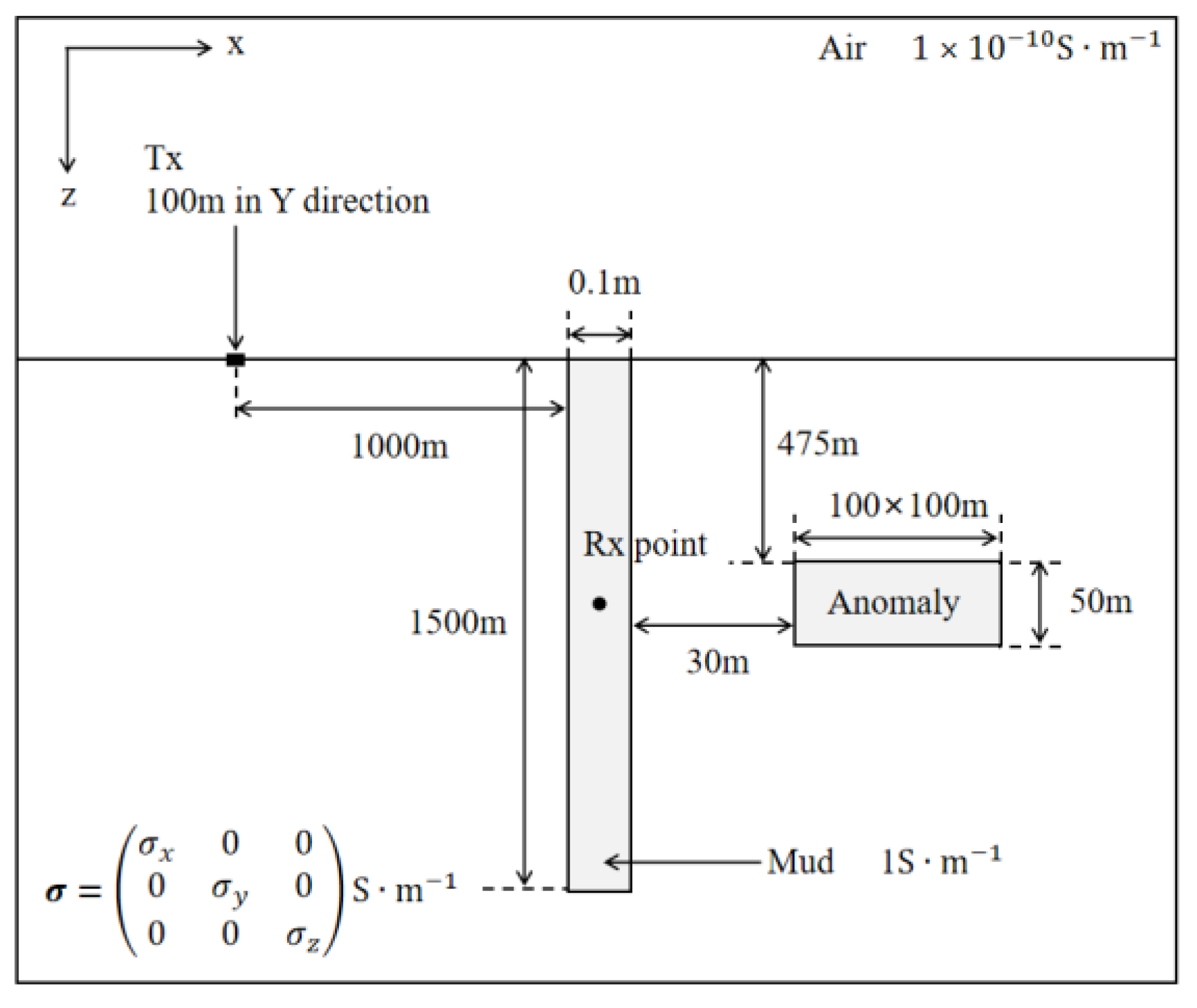
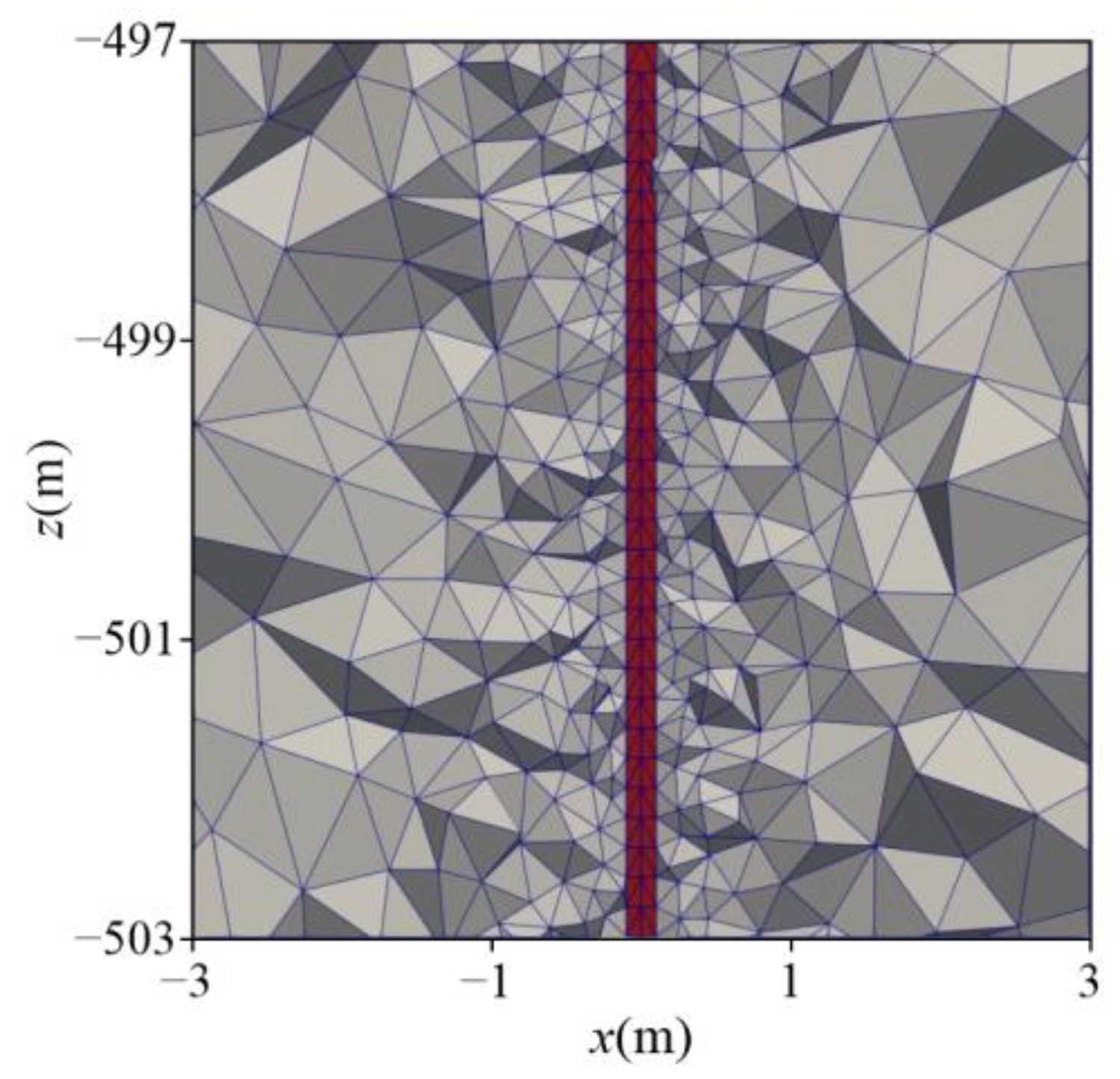
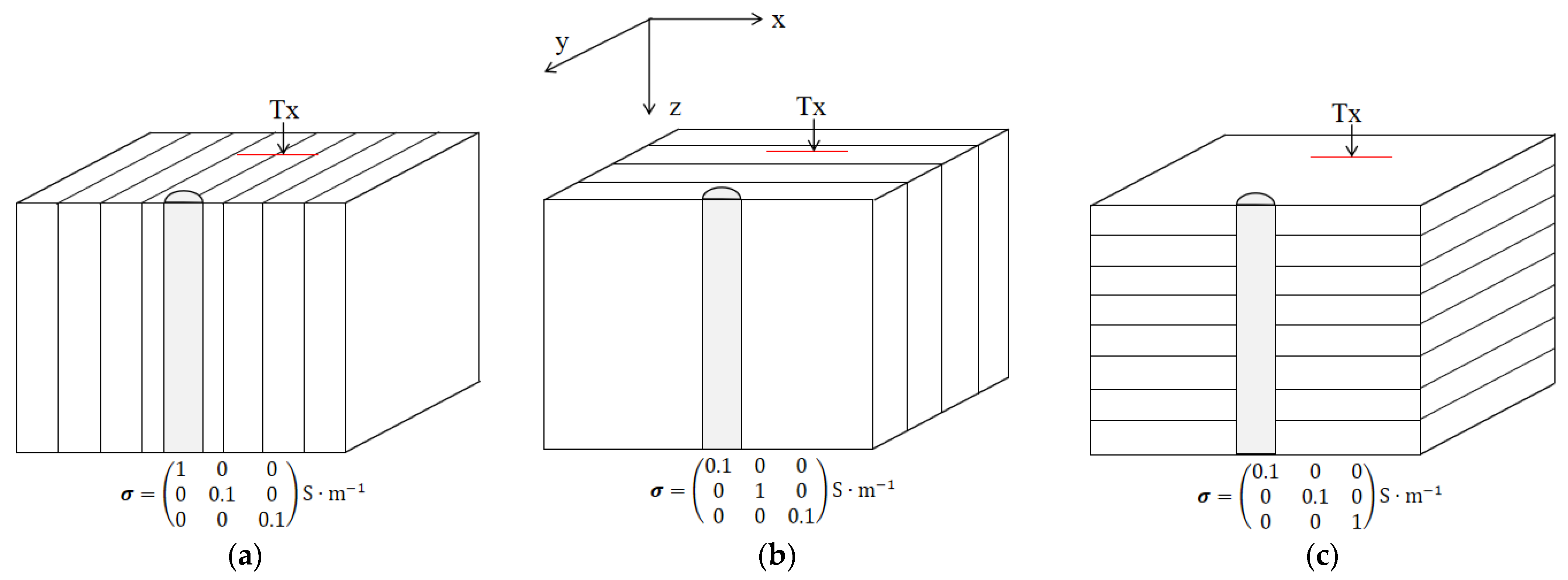
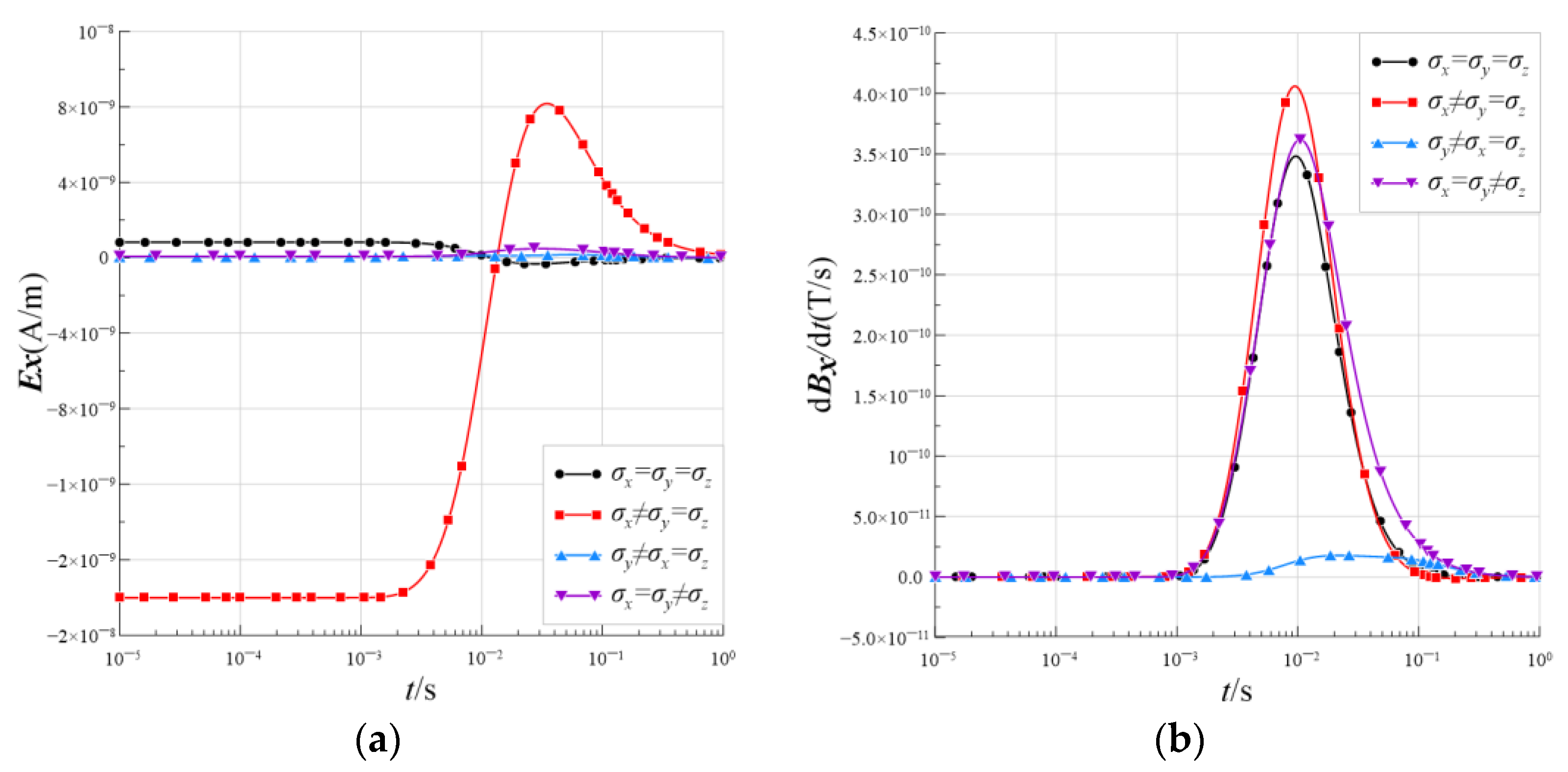

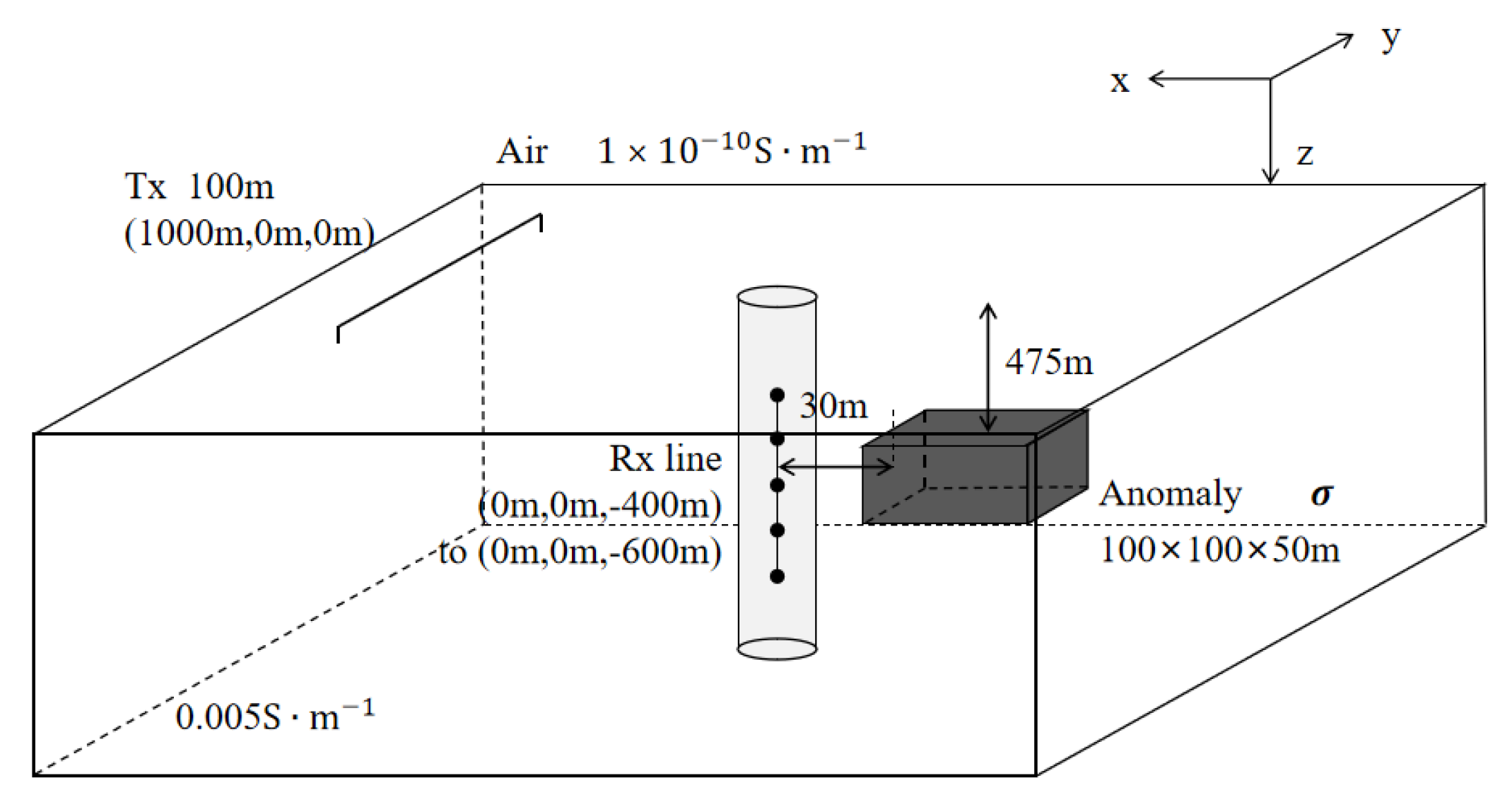
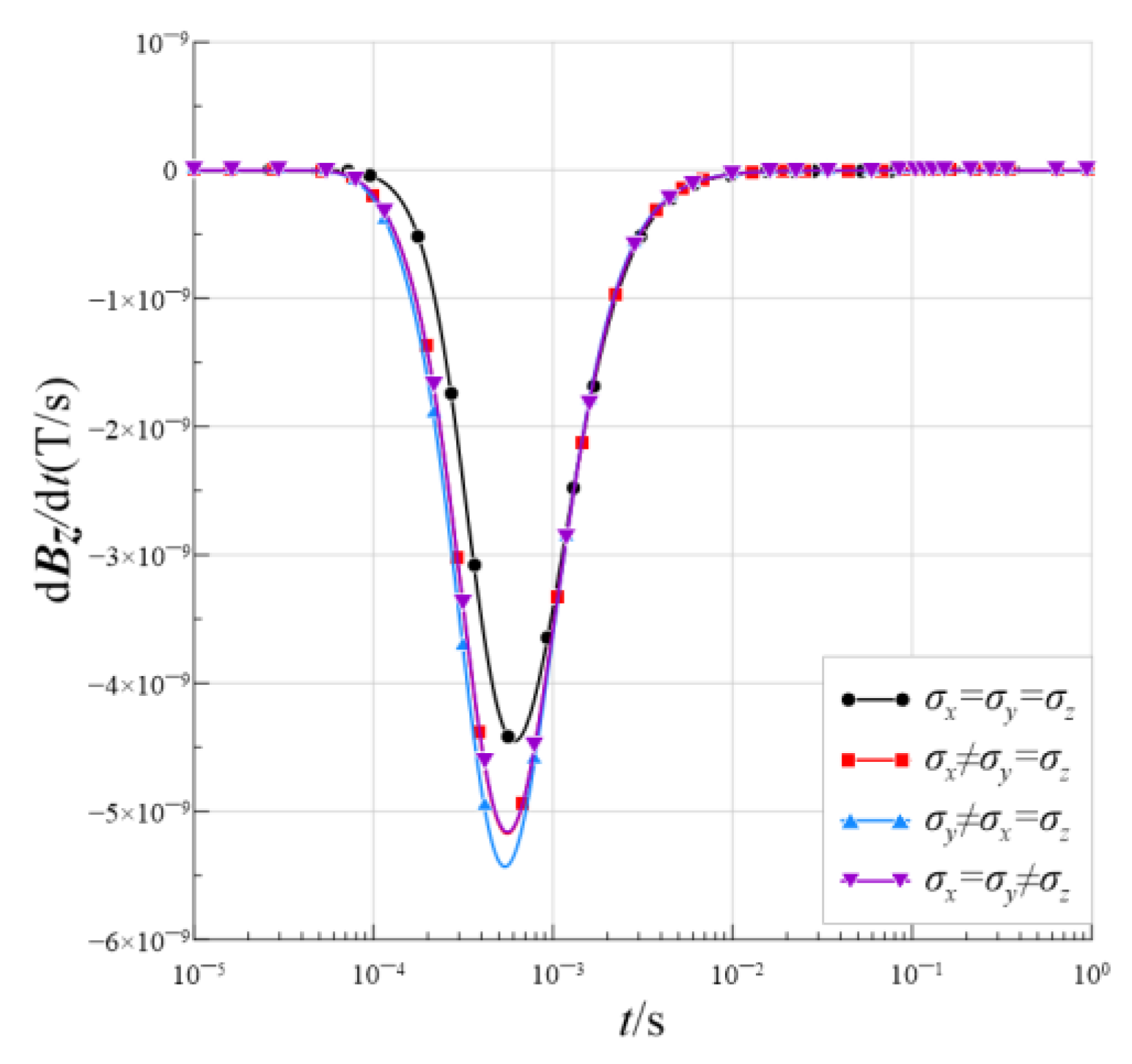
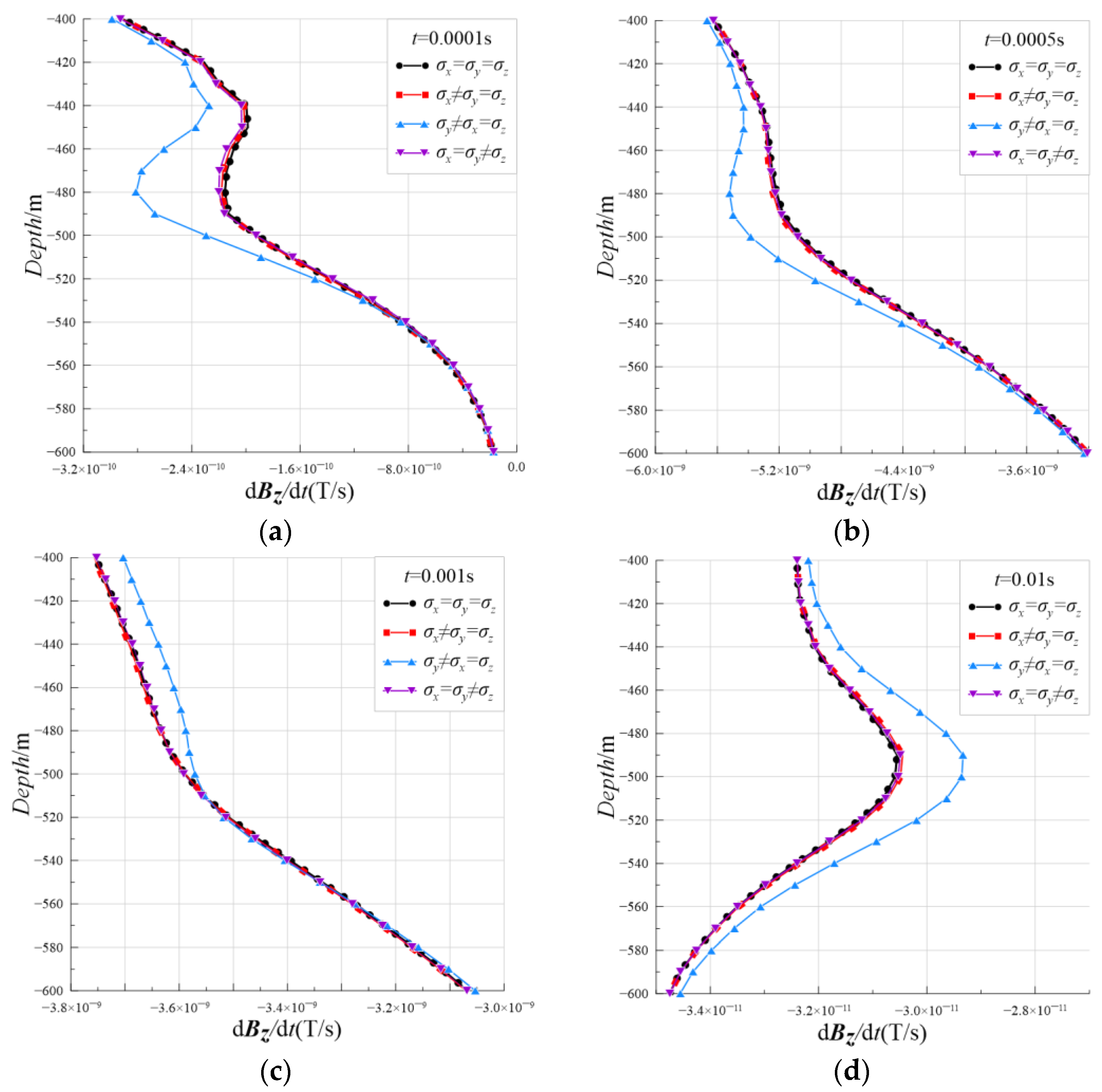
Disclaimer/Publisher’s Note: The statements, opinions and data contained in all publications are solely those of the individual author(s) and contributor(s) and not of MDPI and/or the editor(s). MDPI and/or the editor(s) disclaim responsibility for any injury to people or property resulting from any ideas, methods, instructions or products referred to in the content. |
© 2023 by the authors. Licensee MDPI, Basel, Switzerland. This article is an open access article distributed under the terms and conditions of the Creative Commons Attribution (CC BY) license (https://creativecommons.org/licenses/by/4.0/).
Share and Cite
Li, H.; Mao, Y.; Wang, X.; Yan, L.; Zhou, L. Characterization of Surface–Borehole Transient Electromagnetic Response in Electrical Anisotropic Media. Minerals 2023, 13, 674. https://doi.org/10.3390/min13050674
Li H, Mao Y, Wang X, Yan L, Zhou L. Characterization of Surface–Borehole Transient Electromagnetic Response in Electrical Anisotropic Media. Minerals. 2023; 13(5):674. https://doi.org/10.3390/min13050674
Chicago/Turabian StyleLi, Haojin, Yurong Mao, Xinyu Wang, Liangjun Yan, and Lei Zhou. 2023. "Characterization of Surface–Borehole Transient Electromagnetic Response in Electrical Anisotropic Media" Minerals 13, no. 5: 674. https://doi.org/10.3390/min13050674
APA StyleLi, H., Mao, Y., Wang, X., Yan, L., & Zhou, L. (2023). Characterization of Surface–Borehole Transient Electromagnetic Response in Electrical Anisotropic Media. Minerals, 13(5), 674. https://doi.org/10.3390/min13050674








